
1.Understanding the purpose of research

2.Applying a range of research methods and techniques

3. Presenting research results


1.Understanding the purpose of research

2.Applying a range of research methods and techniques

3. Presenting research results

Posted by Btec TV and Film portfolio at 05:52 0 comments
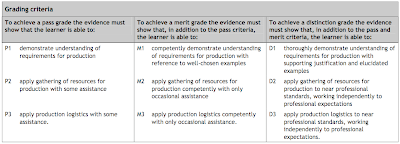
1.Understand requirements for production
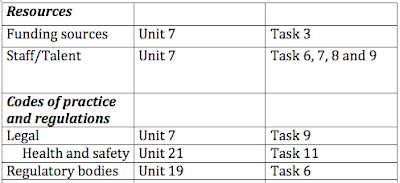
2.Be able to obtain resources for production
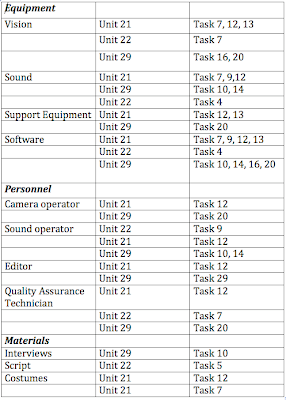

3.Be able to apply production logistics


Posted by Btec TV and Film portfolio at 05:51 0 comments

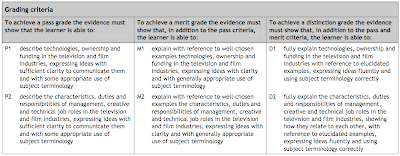

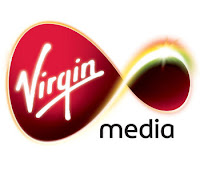
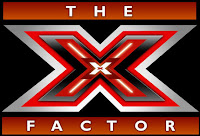
Technology has helped film makers in a number of ways. The use of computer generated images (CGI) for visual effects is better because the quality is higher and effects are more controllable than physical processes e.g. constructed miniatures or hiring extras for crowded scenes. It allows a single artist to produce content without the use of actors, expensive set pieces, or props. (4) Also 3D films have made a big difference. Because of home theaters, movies on demand and portable video players people have less reason to go to the cinema. Therefore numbers of box office ticket sales has not grown. The solution is to raise ticket prices and produce more 3D movies, helping film makers. Attendance to 3D movies is greater than normal movies. Disney and Pixar announced that it will release all of its films in 3D, starting with Bolt. Also DreamWorks Animation says that by 2009 all of its movies will be released in 3D. 3D technology cannot be easily replicated in home theaters which means people will have to do to the cinema to see them. (5)
http://www.sciencedaily.com/articles/c/computer-generated_imagery.htm
http://www.wired.com/techbiz/media/news/2008/04/3d_movies
Task 2 (P1,M1,D1)
Case study: Channel 4
Channel 4 is a terrestrial channel which provides a 'public service'. The service was established in 1981 by the Broadcasting Act. By 1993 its functions were transferred to the Channel 4 television corperation. In contrast with the BBC, Channel 4 takes some risks with its programming. What this channel is for is to; nuture new talents and original ideas, champion alternative voices and fresh perspectives, challenge people to see the world differently and inspire change in peoples lives. It is a unique channel and its constantly developing at technology progresses.
As technology has develeped, Channel 4 has started to offer more services. As well as being a terrestrial channel, it is also available through other digital platforms - satellite and cable. At the moment, Channel 4 uses the internet, as well as television. Channel4.com provides a range of online activities including 4od where channel 4 programs can be watched at any time. It has also expanded in television as it now offers other channels e.g. E4, More4 and Film4. Also included with Film4, the production division produces and c0-produces many feature films for the UK and global markets. Therefore as technology advances, channel 4 expands its service to keep up with the changes and be acsessible in a range of areas. In the current time, television is moving towards HD and 3D. Channel 4 and its other channels are now available to watch in HD. This shows how the channel has developed since it was first established.
Task 3 (P1,M1,D1)
Funding
Public service broadcasting
Public service broadcasting means broadcasting for the publics benefit rather than for commercial reasons. Certain television and radio broadcasters have to fulfill certain requirements as part of their license to broadcast. They have to inform, educate and entertain. The BBC is a purely public service-broadcasting channel and is funded by the TV license. All of the BBC’s television and radio stations, including those that only broadcast digitally have a public service remit. Also all channels broadcast on terrestrial analogue television are obliged to provide public service programming as they can be watched for free nationwide.(1) ITV have some public service broadcasting programs however it is not a purely public broadcasting channel. There is a debate on whether ITV should continue with its PSB remit. Jocelyn Hay, chairman of Voice of the Listener and Viewer says that “ It certainly should. Its PSB programming has been extremely valuble. Even if that programming can't continue at the same level, it should continue broadcasting some of its most important strands - regional, news and children's programming.” However Caroline Binfield, business director TV, Arena BLM says that “TV has been struggling to maintain its audience share, particularly in the younger market. The money invested by ITV in PSB content could be better spent investing in programming that appeals to commercial audiences, so that advertisers maintain their investment in TV” So she thinks that ITV should not continue with its PSB remit. (2)
Subscription
You can now subscribe to get more digital channels. Sky and Virgin media are the two
major broadcasters for digital television. However you can now get a subscription from Tiscali TV, add-ons from BT vision, Setanta sports and Top up TV. Subscribing means signing a contract with your provider and paying a set monthly rate. People in the UK will soon be able to subscribe to a package of Sky channels online without needed to subscribe to the TV service as well. This is happening with many TV subscriptions, they will be available on the Internet. (3) Once you are a subscriber, companies encourage you to subscribe to broadband, phone lines and mobile networks e.g virgin.
Pay-per-view
Pay-per-view is where you choose to pay a one off fee to watch a certain program, which is on a certain channel. This is popular because you don’t have to pay a set price every month to subscribe for the channel, you can just choose to watch a certain programme. People pay to view events like boxing, football and cricket matches. Also people can pay to watch adult channels for a certain length of time. Pay-per-view is more popular in the US. They kind of events that are broadcast on pay-per-view in the US are HD movies, adult entertainment and sports e.g football, basketball, baseball and wrestling.
Sponsorship
Product Placement
Product placement appears in plays, film, television series, music videos, video games and books. It occurs when a brands logo or product is shown or mentioned in a shot. This helps fund a TV program because companies will pay to advertise there product this way. Also it helps advertise the product because if audiences see someone well known using the product or see it on their favorite program it w ill appeal to them more and increase sales of the product.(4) Product placement is illegal in the UK. Andy Burnham the culture secretary said that today, the British government would not accept the European Union directive allowing product placement on UK television. Burnham said that product placement would “contaminate” programming and there should be a firm line between editorial content and advertising. Rupert Howell, ITVs managing director of brand and comercial, has argued that: “Carefully regulated product placement is a legitimate revenue stream that has the added benefit of supporting the production of original UK content” (5)
http://en.wikipedia.org/wiki/Public_service_broadcasting_in_the_United_Kingdom
http://www.mediaweek.co.uk/news/comment/off+the+fence/803889/ITV-continue-its-PSB-remit/
http://newteevee.com/2008/11/10/sky-laun
http://www.guardian.co.uk/media/2008/jun/11/advertising
Task 4 (P1,M1,D1)
Ownership and control
For this task i created a powerpoint presentation to show the ownership and control in the media industries.
Task 5 (P1,M1,D1)
Creative Job roles in Television

Art and design
Art director, assistant Art Director.
Art director’s work on commercials and some types of television productions. When there are large Art departments on television productions Art directors are also in charge of the Art department’s budget and the work schedule and they help the Production designer maximise the money allocated to the department. The hours are long and the job can involve working away from home for long periods of time and they usually work independently on a freelance basis. They learn there skills on the job and they start as an art department assistant and work there way up over the years.
Assistant art directors also work on commercials and some types of television production. They help turn ideas and sketches into reality. There is a strong structure within Art departments and it must function smoothly. The role of the assistant art director is vital in this structure. Like art directors, they work on a freelance basis and have long hours, which can mean working away from home.
Camera
Script Supervisor, Camera Operator (Studio/outside Broadcast), Camera Assistant (Studio/outside Broadcast), Camera Operator (Portable Single Camera), Camera assistant (Portable Single Camera), Lighting Camera (Portable Single Camera).
Script Supervisors are part of the camera department and they make sure that scenes shot make continuous verbal and visual sense. They check the scripts for any errors and inconsistencies, prepare the running times and breakdown the scripts.
Camera operator is a senior role in television camera departments. They must have excellent technical skills and expertise. They are employed in staff positions but many are freelance and shift work and unsocial hours are involved. Camera operators make sure the cameras and equipment are rigged for the required set-up. Must be able to mutli-task i.e. watch, listen, think in their feet while carrying out complex tasks.
Camera assistants support the senior members of the camera departments and go through a practical apprenticeship. They provide general support and learn crucial practical skills.
Lighting camera people have the most senior role in television camera departments as they interpret the directors vision for the program and use there advanced technical skills in lighting and camera work to produce and capture moving images.
Hair and Make-up
Make-up and Hair Designer, Make up and Hair artist, Make-up and hair Trainee, and Make-up and Hair assistant.
Make-up and Hair Designers and artists usually work on high budget television dramas and create looks for the characters in relation to social class, and time periods and any other elements required. They are responsible for the overall design, application, continuity and care of make-up and hair throughout the production.
Lighting
Lighting Director, Gaffer.
Lighting Director - Lighting directors look at the script from the production team and design the specific look needed for each shot. They make extensive preparations before the recording takes place and oversee the set-up and operation of the lights. During recordings they make any final adjustments which they feel are required. Lighting directors usually work on a freelance basis.
Gaffer – Gaffers are responsible for all the practical aspects of lighting sets and locations. They are supervised by lighting directors while they focus each rig according to the relevant lighting plan and are responsible for ordering the required equipment from lighting companies and specify the crewing requirements.
Performers
Actors, Presenter, Stand up Comedian, Walk ons/supporting Artists, Variety artist, Choreographer, Singer, Puppeteer, Assistant Choreographer, Stunt Performer, Agent.
Actors – Actors bring a whole production together, theirs is the public face, which represents many others’ work and efforts. For some roles they have to do extensive research, however some characters are moulded and developed during rehearsals. Actors must be able to learn their lines quickly and be able to take direction, notes and constructive criticism from members of the Directing team. They also have to remember their exact positions and movements at any time during the performance.
Presenter - Presenters work at the front line of television. They introduce and host programmes, read the news, interview people and report on issues and events. They are usually involved in the careful planning that goes into every programme and keep it running to plan. They follow detailed instructions when reading an autocue or script and may write their own material.

Journalism and Sport
Broadcast Journalist- Broadcast journalists must carry out research into all program ideas and they must identify suitable interviewees and locations; relevant background and illustrative footage and locations; visual materials, archive picture and sound footage; articles and features. They also need to know how and when it is necessary to get the required clearances and licences such as copyright and music clearances.
Production
Director, executive producer, location manager, production manager, researcher.
Director - The Director is responsilbe for the look and sound of a production and also they interpret the producers vision. They work closely with the heads of all the departments on a production. They must have a clear vision of the project and what they need to make it work.
Studio and broadcast technology
Network Operations Assistant, transmission engineer, vision mixer.
Transmission engineer - They supervise the transmission of all genres of television programs. They work in the Master control room. Transmission engineers must have a basic understanding of media formats. They manage all the staff in transmission areas, and must ensure that safety plans and risk assessments have been prepared for health and safety reasons. They also have to make sure that the equipment is fit for use and are responsible for quality control of transmission output.
Film Job roles in television and film industries
Creative Job roles in Film

Art department
Production Designer, Art Director, Supervising Art Director, Standby Art Director, Assistant Art Director.
Production Designer - They are basically the head of the Art department and are responsible for it. They are crucial in helping the Director achieve the films visual requirements. The production designers make the Directors vision, a reality. They may be asked to look at a script before a Director is approached, and look at the visual qualities which best suit the script and will create the right atmosphere to bring the story to life. They also have the responsibility of calculating the budgets, and deciding how it will be spent.
Camera
Director of Photography, Script Supervisor, Camera Operator, 1st Assistant Camera, 2nd Assistant, Camera trainee, Steadicam Operator, Aerial Director of Photography, Aerial Camera Pilot, Aerial camera Assistant, Grip, Crane Operator, Video Assist Operator.
Director of Photography - This is one of the major creative roles. They work with the closely with the Director and Production designer and discuss the visual style of the film including lighting which is one of the most important things in filmmaking as it can create mood, drama and excitement for the audience. They create the desired look using lighting, framing and camera movement.
Costume
Costume Designer, Wardrobe Supervisor, Costume Supervisor, Costume Maker, Costume Design Assistant, Costume Daily, Costume Assistant.
Costume Designer -Costume designers are in charge of creating the right wardrobe for the Actors in a production. This involves designing, creating, and acquiring all the costumes. They work at the beginning of pre-production and have to keep to strict budgets and tight schedules. They must be organised and have to confidence to manage a team and keep them motivated.
Editing and post Production
Editor, Post Production supervisor, Assistant Editor, Titles designer, Second Assistant Editor.
Editor - The editor has an important role in the making of a film as they are the ones who take all the footage that has been shot and turn it into a film. They have to insure that the story flows from beginning to end and makes sense for the audience. Editors have to work long hours often under pressure and they are employed on a freelance basis.
Screenwriter, Development Executive, Script Editor, Script Reader.
Screenwriter - Screenwriters have great influence over the creative direction and emotional impact of a screenplay as they are responsible for researching the story, developing the narrative, writing the screenplay, and delivering it. They almost always work on a freelance basis and usually pitch original ideas to producers in the hope that they will be optioned or sold or are asked by a Producer to create a screenplay from a concept, true story, existing screen work or literary work. Being a screenwriter is emotionally and intellectually demanding.
Non-creative Job roles in Film

Accounts
Financial Controller, Production Accountant, Key Assistant Accountant, Assistant Accountant, Accounts Trainee.
Financial Controller - These are responsible for accounting, taxation ad financial analysis for a company. On some productions they may be required to work with the producers to prepare budgets and raise the necessary finance.
Production Accountant - They are responsible for managing finances and maintaining financial records during a film production. They help to prepare schedules and budgets as well as managing day to day accounting office functions. Also they are responsible for calculating finances, costing production, liasing with financiers, and controlling the cash flow to ensure that payments are made on time, and in accordance with agreements and approved budgets. Production Accountants usually work on a feelance basis.
Casting
Casting Director, Casting Assistant
Casting Director - They organise the casting of actors for all the roles in a film. Once the parts have been cast, the Casting Director negotiates fees and contracts for the actors and acts as a liason between the Director, the actors and their agents. They must have extensive knowledge of actors and their suitability for a particular role. Also they must liase with the Director and Producer to understand their requirements and suggesting ideal artists for each role.
Catering
Catering crew
Catering crew - As film crew work hard, long hours, they need to make sure that they still eat well. The Catering is provided by special companies who drive catering trucks packed with food and a range of equipment to each Unit base. On big films, the Catering crew generally involves Unit leaders, Location chefs, Salad persons and Dish washers. With all jobs in the catering buisness, the hours can be long and the work is hard.
Distribution
Distributor, Marketing and Publicity Manager, Publicist, Marketing Assistant, Sales Agent.
Distributor - They help film makers to realise their full potential by informing the widest possible audience about the films they release. Distributors may compete for the rights to release a film. On each film they liase with a variety of professionals to sell the film to the media, marketing partners, exhibitors and the public. Because all films are different, the Distributors must create a new film release plan for each project.
Exhibition
Programmer, Projectionist
Programmer - Programmers choose films for a specific venue or for a film festival. The job requires in-depth knowledge not only of the films but of the target audience as well. It involves biulding good relationships with film distributors to ensure that films are not allotted to competitors. Travelling may be required for this job and they may have to work to specific budgets.
Projectionist - These are responsible for ensuring that films are projected at the right time and without technical problems. Care and attention is required in order to acheive smooth running operation, resulting in standards of presentation that are acceptable to modern audiences. They generally work on their own and must be able to solve technical problems quickly and efficientlly.
Health and Safety
Health and Saftey Advisor/Consultant, Paramedics and Paramedical staff, Unit Nurse.
Health and Saftey Advisor/Consultant - This job involves giving advice on health and saftey managment system within each production, reviewing each companys health and saftey policy, and ensuring that health and saftey arrangements and the appropriate personnel are in place.
Locations
Unit Manager, Location Manager, Assistant Locations Manager.
Locations Manager - Their main role is to find appropriate loactions for a film shoot. They have to negotioate with each locations owner on a number of issues to ensure that they can use this location. Once the filming at a certain location has started, the Location Manager is in charge of managing all aspects of shooting and making sure the location is handed back to the owner in a satisfactory state.
http://www.skillset.org/film/jobs/
Task 6 (P1,M1,D1)
For this task I chose a particular role from the TV and Film industry and i was interviewed about this job. Here is a recording of the interview:
Task 7 (P1,M1,D1)
Contracts.
Attachment- This means that you work on a particular project for a certain period of time, working with a company. This is a contract which has to be completed before moving to a different project.
Fixed term- This is similar to an Attachment contract. A fixed term contract has a definate start and end, and is often for a short period of time. With regards to the film industry, it usually means that the person will work on a certain film untill the contract expires.
Freelance- In television and film, freelance workers are very common. They work the hours they want to work and can be their own boss.
Voluntary- This is generally when a person does a particular job without being paid for it. This is so the person can gain the work experience they need to get a job in the future.
Task 8 (P1,M1,D1)
Risk assessment: Task 11 - Unit 21 - Single camera techniques
Task 9 (P1,M1,D1)
Media Legislation
Health and saftey: This is important for every employer to consider. There are over 150 serious injuries in the UK media industries every year. In a studio or set the potential hazards are enormous. These risks have to be properly assessed and managed, otherwise mistakes can be made which could cause thousands of pounds owrth of damage, injury or even death to the cast and crew. This is why health and safety is taken very seriouly in the media industry and it should be every professionals first obligation to themselves and everyone in the workplace.
Equal opportunities: This is important for a company to offer as UK audience is diverse so options should be available to everyone without discrimination.
The BBC is committed to providing equal opportunities for everyone regardless of their colour, race, religion, ethnicity, gender, sexuality, disability or age. It is also committed to making its services accessible to all the above. This applies to their output as well as employees.
"The BBC aims to create and sustain an inclusive work environment which provides equality of opportunity for everyone,"
Employment Equality (Age) Regulations 2006: This law basically makes it illegal to discriminate against employees, job seekers and trainees due to their age.
Employer's liability: The Emploper's liability act 1969 says that Employer's have to have at least a minimum level of insurance cover against claims such as if an employee is injured at work, or becomes ill from working, they may want to claim compensation if they believe that the Employer is responsible. This is because employer's are responsible for the health and saftey of their employees while they are at work. Therefore most employers are required to insure against liability by the law.
Intellectual Property: This basically represents the property of your mind or intellect. In other words it is a set of legal property rights which give a company or individual the right to protect materials which were created by them. This includes inventions, trademarks, original designs or the practical application of a good idea.
Copyright: This is a form of Intellectual Property. It is the set of exclusive rights given to the author or creator of original work, including the right to copy, distribute and adapt the work. Copyright is common in the media as it is important for work and ideas to be protected from competitors, and copyright gives this proctection for a certain period of time.
http://www.bbc.co.uk/aboutthebbc/policies/diversity.shtml
Comments:
Unit 7:
Distinction 1: Issues surrounding technologies ownership and funding in the television and film industries will be evident. Relevant examples are cited that evidence understanding and discussed in detail using sophisticated language.
Distinction 2: Correct and substantial descriptions of common job roles in the television and film industries. A detailed understanding of the characteristics of different duties in management, administrative and creative roles are evident through sophisticated discussions.
Posted by Btec TV and Film portfolio at 05:49 0 comments

The narrative structure of a film or television program is important. A linear of sequential narrative is where the events that occur in the program are in chronological order, with a beginning, middle and end. Soaps generally have this structure giving us endless linear narratives. Another example of a linear narrative is Slumdog Millionaire. It is about a teen that grew up in the slums and becomes a contestant on the Indian version of who wants to be a millionaire. It has a linear narrative as the events are in chronological order. However it has some elements of a non-sequential narrative with the use of flashbacks, which show events from the teen’s life history. This is an example of where linear and non-linear narratives can function together.
Non-linear or non-sequential is where events are not shown in chronological order or when we see the same event from different points of view. An example of this is the TV series Lost. It begins with a linear narrative of the characters crashing on an island and working together to survive. As the series progressed, it started to have time travel in the narrative, which changes the narrative to non-sequential as it moves backwards and forwards through time. Flashbacks are a form of non-sequential narrative that involve details of the past being revealed before us on the screen. With Lost, the flash backs are a key to the shows success. It continuously shows flashbacks of previous events and tells the characters stories through these flashbacks. Also in one of the later series, it starts to show flash-forwards.
Films and TV series can have patterns within there narratives. Goal-orientated plots can dominate the main narrative of a story. For example in the film Taken it centres around the character, Bryan Mills goal to find his daughter who was kidnapped when on holiday in Paris. He has to find her before 72 hours has gone or he could lose her forever to trafficking. This is also a good example of a journey in a narrative. A journey in a narrative can be a physical journey or a metophorical journey. He goes through the physical journey of finding his daughter, but also goes through an emotional journey because he realises the mistakes he has made with his daughter so desperately wants to find her and put things right. . Search or investigation narratives are usually crime dramas for example CSI. Climaxes in films are usually the most important events in the film, showing the last acts of the main characters.
The range of information is important in the narrative. If it is an unrestricted narrative then the audience sees and hears everything and often they already know the ending. For example in the film Pearl Harbour, because it was a historical event the audience already knows what’s going to happen. Also as the film progresses, the audience can see that the Japanese are planning an attack on pearl harbour, but the main characters are unaware. If it is a restricted narrative then the audience are introduced to information and plot at the same time as the characters.
Propp’s theory is that every narrative has to have a Hero, a Helper, a Villain and a Damsel-in-distress. This is present in the majority of films and TV dramas, which are made. An example which supports Propp’s theory is the film Pirates of the Caribbean – the curse of the black pearl. In this film William Turner (the hero) wants to save the women he loves, Elizabeth swan (the damsel-in-distress) who has been kidnapped by the pirate Captain Barbossa (the villain). He does this with the help of Jack Sparrow (the helper).
Todorov's theory is that there are five stages the narrative can progress through. These are: A state of equilibrium, A disruption of that of that order, A recognition that the disorder has occurred, An attempt to repair the damage and A return or restoration of a new equilibrium. In simpler terms this theory is basically that every narrative needs an equilibrium, a disruption and a resolution. We seek a beginning, middle and end in everything, however it doesn't necessarily have to appear in that order.
https://blogger.googleusercontent.com/img/b/R29vZ2xl/AVvXsEgUajQkcDWRKmci8PY8AYvewGrBbTQ30rkSbKjFvWYPdpKfFfBeecWVkM2-220a779YBFZQAzF7E2BNG13WxV1CDlLDDaxcQIKW27UT6-borbOIbm2E8c9B9S_5Cj8FNWLLzc7cRp-tIpaA/s1600-h/Todorovs+theory+of+narrative.jpg http://www.imdb.com/title/tt1010048/
Task 4 (P1,M1,D1)
Se7en
This clip is a remake of a scene from the film Se7en and has a variety of camera shots. The scene begins with a tracking shot of a young girl walking through a car park, and is also an extreme long shot which sets the scene for the audience. Then it quickly switches to a long shot of two men getting out of a car and walking towards what appears to be were the girl is. It then switches back to a tracking shot of the girl walking. After this there is an extreme close up of half of her face, and she has tears in her eyes which adds intensity to the shot. The lighting in these shots is natural lighting which makes the area in which the character is, dark which connotes that the character is dark and mysterious. Also the sound is diegetic, with sounds of the surrounding area e.g. footsteps, cars and trains.
The scene moves on to a close up of the characters feet, were it appears that she is about to step off the edge onto the train track. During this shot, there is the diegetic sound of footsteps coming towards the character. The audience can see the feet of the two mean in this shot, then it moves to a medium long shot of all three characters which shows the interaction of the characters as the dialect begins. The two men ask Joan, the main character who she is, which leads to her kneeling down, then there is a close up of her face. This immediately turns into a flashback.
The flashback is shown in grey to signify to the audience that it is something that previously happened. Also the camera is disorientated and the shot is slightly out of focus which adds to the effect that it is a flashback. The scene continuously switches back and forth from the flashback to the current situation while the narrative of who Joan is and what she has done unfolds.
Towards the end of the scene, there is a medium close of Joan and one of the men, and non-diegetic music begins which conveys that something is about to happen as it adds to the intensity of the scene. Then, along with the music there is the sound of a train in the distance. The shot moves to a close up of Joans face, with the two men in the background. She then steps onto the train track, and the music becomes louder and more intense. The camera advances and becomes shaky which implies that there is oncoming danger, and the shot becomes dark and out of focus. The scene ends with the sound of the train getting louder, then it ends which suggests that she is about to get hit by the train.
Task 5 (P1, M1, D1)
In the early days of media and television, it was extremely different in comparison to now. 20 years ago there was no Internet or Sky. For example in the USA there were only 3 main television networks throughout the television industry at this time. Also there would be on average, one television per household, which made watching television a social event between the family and the community, and everyone in the house would sit down together and watch a program.
Every type of media including radio and newspapers has a target audience. However, in the early years of television a single program would attract a wider, broader audience than today. For example in 1992, an episode of the sitcom Only Fools and Horses had viewing figures of 20.1 million, whereas now, an episode of X factor, which is one of the most popular shows on British TV today, only has viewing figures of around 10 million.
"Television can no longer rely on mass audiences" – Rupert Murdoch
Now there is a variety of ways in which audiences can view programs. Television networks such as Sky and Virgin media have a wide variety of TV channels which you can watch. This is very different in comparison to when there were only two channels to choose from. Because of the variety of channels, it means that television programs no longer generate mass audiences because there is something for every taste.
"You are growing up in a digital world where you send emails on you cellphone" - "this is what i mean by creative destruction, everyday new technologies is tearing down old ways of doing business" – Rupert Murdoch
Not only is there more choice, but you can now watch your favorite programs on the internet on websites such as Hulu.com. This is why a single program doesn’t generate mass audiences, because different programs appeal to different target audiences which means TV is no longer a social event.
Task 6 (P1, M1, D1)
 The software we will use will mainly be iMovie, which we will use to edit the footage we have shot and add the effects, titles and non-diegtic music we require. The sound which we recorded using the voice recorder, we will edit on garageband, which we can also use to add sound effects. For more advanced editing we may use final cut express, as it allows you to have more complicated effects.
The software we will use will mainly be iMovie, which we will use to edit the footage we have shot and add the effects, titles and non-diegtic music we require. The sound which we recorded using the voice recorder, we will edit on garageband, which we can also use to add sound effects. For more advanced editing we may use final cut express, as it allows you to have more complicated effects.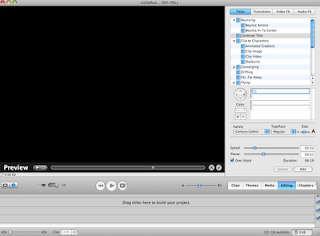
For our production there will be three characters involved (“Little red riding hood”, hooligan 1 and hooligan 2). Also we will have at least 3 people monitoring the camera, props and sound equipment at all times. We may also have an extra person for additional help. The props we will use basic everyday items e.g. bag, mug, however for the introductory scene we went to the drama department as we needed old-fashioned props. From here we will use a red poncho for “red riding hood’ and also a basket to connote the fairytale image.
· AlAll footage will be shot in high resolution DV
The sound throughout the film will be non-diegetic in the form of music. The music will change in each scene to emphasize the mood in which we portray. However at points there will be diegetic sounds, overriding the music. Near the beginning the music will jump from classical to modern, which juxtaposes the modern world with the fairy tale world.
There will be integration of flashbacks of the character looking back at when she was attacked. They will be shown throughout the film in 3-4 second intervals.
The faces of the hooded characters (hooligans) which attack the main character will not be distinctly shown, to add to the sinister atmosphere and emphasize the vulnerability of the victim. There will also be close ups of the victims face, to show her emotions as she looks back on the event.
Proposed Sequence Sample of Events:
Th introductory scene will be an establishing the fairytale character "red riding hood" skipping through a forest, her clothing will also match the fairytale image. We are going to use the fairytale theme at the beginning to relate to the audience. Also there will be non-diegetic classical music, to add to the fairytale effect. These aspects are also to emphasize the cheerful mood of the character at this point and show that she is unaware of the situation she is about to be faced with.
The following scene will cut to the character appearing through the trees into a more open space, wearing modern clothes in contrast to what she was previously wearing. There will be modern upbeat music accompanying this to portray that the film has now moved away from the fairytale image into reality.
In the next scene, the character will be walking through the woods, when she gets attacked by two hooligans. This will be shown in slow motion and black and white to emphasize the seriousness of the situation and draw the audience into the drama of the situation. Also the music changes from a modern, upbeat sound, to a classical, dramatic instrumental.
During the scene of the attack, there will be jump cuts of the lead character sitting in her home, as she remembers the event. She will be seeing the event in the form of flashbacks. There will be close ups of her face to show her vulnerability and emotions as she looks back on the incident.
The next scene will begin with a point of view shot of someone moving toward the house were the main character is, the audience will know this, as the character will be seen through the window of the house. This will add drama to the seen as the audience will not know who is walking towards the house or why. There will be diegetic sounds throughout this scene.
The final scene will begin with a medium shot of the main character in her house, and she walks out of the room. The window in which the audience previously saw from the outside will be visible in this shot. After the character has walked out of the room, the faces of the hooligans will appear in the window. Then the camera will zoom into an extreme close up of one of the hooligans faces. Then it will fade to black. This is where the film will end.
D1 Critical evaluations of single camera productions are fluent and arguments are supported using elucidated examples and the correct subject terminology.
Targets:
I am being picky but can you mention the lighting in greater detail in task 4.
Otherwise a superb unit so far, well constructed, sophisticated analysis and attention to detail. You have really improved over the last few months and your command of the appropriate language is superb. Well done.
Unit 21:
Please see previous targets and if acted upon the following mark will apply…
Distinction….
D1 Critical evaluations of single camera productions are fluent and arguments are supported using elucidated examples and the correct subject terminology.
D2 Single camera production planned to a quality that reflects a near-professional standard, showing creativity and flair. Work has been carried out independently and reflects professional expectations.
D3 Within the production there is evidence that the technical quality reflects near professional standards, taking in to account the equipment available. The production shows creativity and flair and the student has shown great independence in striving to meet professional expectations.
Posted by Btec TV and Film portfolio at 05:48 0 comments